A thoroughly maritime city, Norfolk, Virginia is home to Naval Station Norfolk, the world's largest naval base, and the headquarters of the United States Navy's Fleet Forces Command, as well as numerous shipbuilding and repair facilities and a thriving commercial port. The city lies along the east shore of the Elizabeth River, at the southern end of Chesapeake Bay. The revitalised waterfront offers dining and entertainment venues at the Waterside District and the 16.9 kilometre (10.5 mile) Elizabeth River Trail runs along the riverside past many attractions, including the Nauticus maritime museum and science centre and the USS Wisconsin museum. A popular attraction is the harbour sightseeing cruise, which offers naval enthusiasts an opportunity to see many of the dozens of US Navy vessels homeported at Naval Station Norfolk, including.aircraft carriers, cruisers, destroyers, amphibious assault ships, submarines, and auxiliary vessels. Enjoy this photo tour of Norfolk's waterfront and a sightseeing cruise along the Elizabeth River.
Photos taken 2-5 April 2018
.JPG) |
| The view from the 16th floor of the Hilton Norfolk The Main hotel in downtown Norfolk, Virginia. Portsmouth, Virginia can be seen across the Elizabeth River, while a United States Coast Guard cutter proceeds through the harbour, likely en route to one of the many docks and maintenance facilities along the river operated by the US Government and defence contractors. |
.JPG) |
| The Waterside District building, as seen from the boardwalk that runs along the Elizabeth River. Opened in May 2017, the Waterside District building features various trendy restaurants and bars. The development is part of the broader post-war revival of the previously gritty and industrial Norfolk waterfront. The Waterside District building sits between Waterside Drive and the Elizabeth River, in the heart of downtown Norfolk. |
 |
| One of the Elizabeth River ferries that crisscrosses the Elizabeth River between Norfolk and Portsmouth, Virginia. Ferry service on this route commenced in 1636 with a rowed skiff for pedestrians. In 1720, a larger ferry, still powered by oarsmen, began carrying horse-drawn wagons and other wheeled vehicles. By 1794, six oared ferries were operating on the route, and in 1821 horse-powered paddle-wheel vessels replaced the oarsmen. The first steam-powered Elizabeth River ferry, Gosport, entered service in 1832 and reduced the river crossing time to five minutes. In 1840, the passenger fare was three cents. Later, in 1918, the ferry was carrying 40 automobiles and 200 passengers each trip. With the opening of the Downtown Tunnel to Norfolk in 1952, use of the ferry dropped off and it ceased operations in 1955. Ferry service was restored between Norfolk and Portsmouth in 1983. Today, Hampton Roads Transit operates three 150-passenger ferries every 30 minutes or every 15 minutes during summer peak times on weekends. |
 |
| The steel-hulled, three-masted top sail schooner American Rover, moored next to Town Point Park along the Elizabeth River. American Rover was built in Panama City, Florida and fitted out in the Willoughby area of Norfolk before entering service in 1986. Her design was inspired by the 19th century cargo schooners that once plied the waters of the Atlantic Seaboard and Chesapeake Bay. She measures 135 feet in length, with a 24-foot beam, and a 9-foot draught. Displacing 105 tons, American Rover carries 5,000 square feet of sail and can carry 129 passengers at a top speed of 11.5 knots (21.3 km/h). |
.JPG) |
| The M80 Stiletto, an 88-foot pentamaran-hulled high-speed craft owned by Naval Sea Systems Command and used to test new technologies for the US Navy, especially those for Navy Special Warfare forces. Capable of speeds up to 60 knots (111.12 km/h), Stiletto has a draught of only three feet, making it ideal for littoral and riverine operations. It can travel 500 nautical miles at 40 knots, and possesses a small flight deck for unmanned aerial vehicle (UAV) operations, as well as a rear ramp that can launch and recover 11-metre rigid-hulled inflatable boats and autonomous underwater vehicles. Weighing just 45 tons unloaded, Stiletto can be hoisted aboard cargo vessels. |
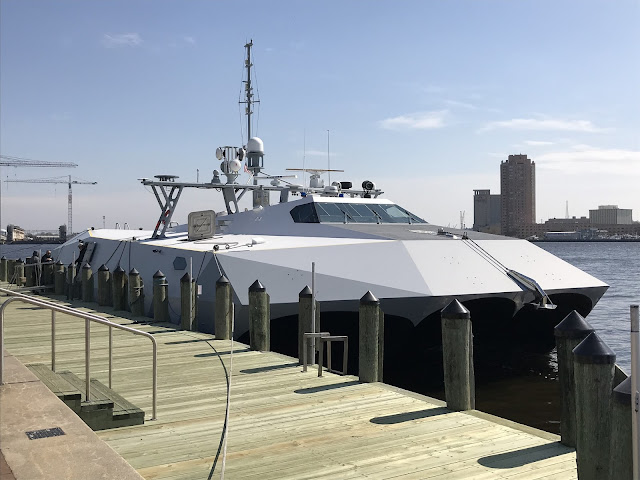.JPG) |
| The Stiletto is the largest vessel constructed of carbon fibre and advanced composite materials. When this photo was taken, Stiletto was preparing to sail from Norfolk to Washington, DC to participate in the annual Sea, Air, Space trade show and symposium. |
.JPG) |
| Looking along the Elizabeth River Trail. A short distance offshore sits the zero mile buoy marking the beginning of the Atlantic Intracoastal Waterway. An information plaque notes that water transportation was the primary means of moving cargo in colonial times and that the idea of a canal connecting the Elizabeth River with the Albemarle Sound in North Carolina originated in 1728 during Colonel William Byrd's surveying expedition of the Virginia-North Carolina border. Construction of the Dismal Swamp Canal commenced in 1793 and was completed in 1805, with further excavations to widen and deepen the canal being completed in 1828. A second canal, the Albemarle and Chesapeake Canal, was built between 1855 and 1859. Today, both canals form part of the Intracoastal Waterway, providing inland passage for both commercial vessels and pleasure craft. |
 |
| The 1,151 gross ton MV Spirit of Norfolk sightseeing boat featured lounges, dining areas, and a bar in its two enclosed decks and open-air rooftop observation deck. Launched in March 1992, the vessel completed a $1.2 million refurbishment in 2016 and could carry over 400 passengers on sightseeing cruises, dinner cruises, and private charter event cruises along the Elizabeth River. On 7 June 2022, a fire broke out in Spirit of Norfolk's engine room during a harbour cruise with 108 passengers aboard. Although the passengers were rescued by the sightseeing vessel Victory Rover and Spirit of Norfolk was towed to a pier at Naval Station Norfolk so that firefighters could battle the blaze, the vessel was ultimately declared a total loss. |
 |
| An early spring day at Town Point Park. Comprising seven acres along the Elizabeth River in downtown Norfolk, the park hosts various outdoor concerts and festivals, including Norfolk Harborfest, Bayou Boogaloo, and Fourth of July events. Town Point Park was given a complete redesign in 2008-09, being reopened to the public by July 2009. An American flag flies over the Armed Forces Memorial at the southwest corner of Town Point Park. The memorial features 20 bronze plates engraved with letters home written by US military personnel, from the American Revolutionary War to the Gulf War, who died after writing their letters. The plates are scattered across the plaza as if strewn by the wind. |
 |
| The Peter G. Decker Jr. Half Moone Cruise and Celebration Center, a conference and event venue, also equipped to dock cruise ships. Opened in April 2007, the Half Moone Center is named after the Half Moone fort that was built on this site in 1673 to protect Norfolk's growing maritime trade from Dutch ships which attacked British merchant vessels in the years after the 1664 British conquest of New Amsterdam (subsequently renamed New York). The fort's construction pre-dated the founding of Norfolk and the site was at that time called Foure Farthing Point. Authorised by the Virginia Assembly, the fort was designed in a half-moon shape and armed with demi-cannons and culverins to cover the broad stretch of river at this point. The long-barrelled culverin was capable of accurately shooting an 18 pound (5 inch) cannonball to a distance of 1,300 yards. The cost to Lower Norfolk County of building the fort was 35,000 pounds of tobacco. One of Norfolk's iconic mermaid sculptures adorns a fountain outside the Half Moone Center. |
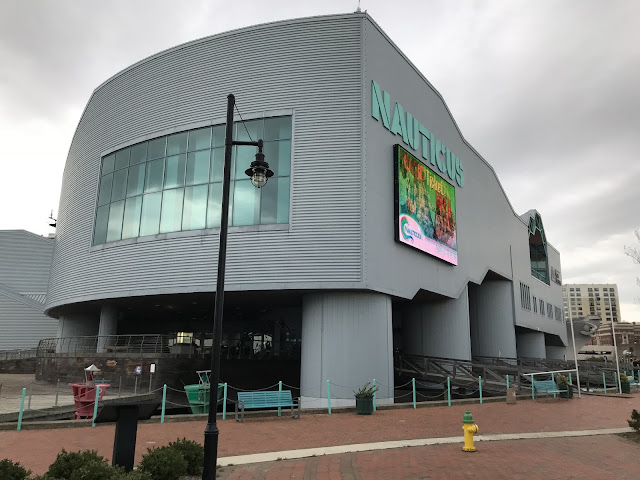.JPG) |
| An exterior view of Nauticus, home to a maritime-themed science centre and museum, the US Navy's Hampton Roads Naval Museum, and the battleship USS Wisconsin. |
.JPG) |
| A view of the Nauticus building and the Peter G. Decker Jr. Half Moone Cruise and Celebration Center from the adjacent breakwater. |
 |
| A view down the Elizabeth River from the Nauticus museum. |
 |
| Freemason Harbor on the Elizabeth River, at the west end of downtown Norfolk. The Pagoda & Oriental Garden lie at the head of Freemason Harbor. |
.JPG) |
| Proposed by the Taiwan Provincial Governor (and later President of the Republic of China) in 1983 during a goodwill trade mission to Norfolk, the two-storey octagon-shaped Pagoda was built in 1989 on and around pillars that had previously supported a 500,000 gallon molasses storage tank built in 1918. Materials for the Pagoda were manufactured in Taiwan and shipped to Norfolk where they were assembled by Taiwanese builders. The Pagoda now houses an Asian-themed restaurant and tea room. The Elizabeth River Trail runs through a gate into the Chinese-inspired Oriental Gardens dominated by the Pagoda (also known as the Marine Observation Tower), a gift to the Commonwealth of Virginia and the City of Norfolk from the Taiwan Provincial Government. The gardens feature species of plants native to Asia, granite lanterns, and a Koi pond. The gardens were dedicated in October 2000. |
.JPG) |
| The Victory Rover tour boat, moored at Town Point Park prior to departing on its regular 11:00am - 1:00pm harbour cruise, 3 April 2018. The Victory Rover measures 95 feet long by 21 feet wide, and is powered by three triple screw 1271 Detroit Diesel engines producing 1,300 horsepower. The vessel is certified to carry 149 passengers. The highlight of the harbour tours provided by Victory Rover is the cruise past Naval Station Norfolk, the world's largest naval base. Naval Station Norfolk occupies four miles of the Hampton Roads waterfront, and features the largest concentration of US Navy forces, with over 70 ships homeported there. The station supports US Navy forces assigned to United States Fleet Forces Command, as well as those operating in the Atlantic, Mediterranean, and Indian Oceans. US naval air forces conduct over 100,000 flights in and out of Naval Air Station Chambers Field, adjacent to Naval Station Norfolk, equating to one flight every six minutes. |
 |
| The ticket for the Victory Rover Naval Base Cruise, 3 April 2018. |
 |
| The Norfolk waterfront, as seen from the deck of Victory Rover as it cruises up the Elizabeth River before heading downriver toward the Norfolk Naval Base. |
 |
| A view of one of the ship repair facilities along the Elizabeth River in Norfolk. Here, the Arleigh Burke-class destroyers USS Truxtun (DDG-103) and USS Stout (DDG-55) undergo maintenance and upgrade work, with white plastic covering over delicate sensors on the mast of the Truxtun. Truxton commissioned into the US Navy on 25 April 2009 and Stout commissioned on 13 August 1994. Lying next to the two ships is YRBM-36, a YRBM-31 class Repair, Berthing and Messing Barge used by shipyard workers. |
 |
| Passengers on the Victory Rover look at the Whidbey Island-class dock landing ship USS Tortuga (LSD-46) on the left in drydock, and the Wasp-class amphibious assault ship USS Bataan (LHD-5) on the right. The 16,568 ton Tortuga commissioned on 17 November 1990 and the 41,000 ton Bataan commissioned on 20 September 1997. |
 |
| Shipyard cranes tower over the San Antonio-class amphibious transport dock USS Mesa Verde (LPD-19). The 24,433 ton ship is 684 feet long and can carry up to 800 fully-equipped Marines, in addition to its crew of 28 officers and 83 sailors. The onboard hangar and flight deck allows the ship to simultaneously operate four CH-46 Sea Knight helicopters or two MV-22 Osprey tiltrotor aircraft. USS Mesa Verde commissioned into the US Navy on 15 December 2007. |
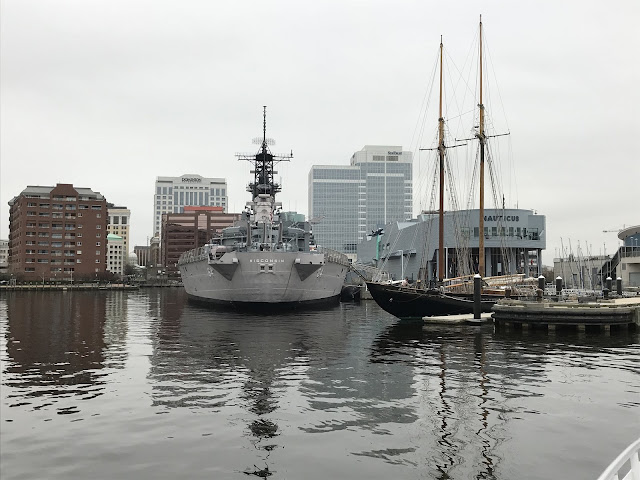.JPG) |
| Victory Rover passes astern of the retired Iowa-class battleship USS Wisconsin, now a museum ship moored next to the Nauticus science and maritime museum. |
 |
| More US Navy ships moored at Elizabeth River shipyards. Seen here are the Ticonderoga-class guided missile cruiser USS Vella Gulf (CG-72), the Whidbey Island-class dock landing ship USS Whidbey Island (LSD-41), and the Arleigh Burke-class destroyer USS Mahan (DDG-72). Vella Gulf commissioned on 18 September 1993 and was decommissioned on 4 August 2022. Whidbey Island commissioned on 9 February 1985 and decommissioned on 22 July 2022. Mahan commissioned on 14 February 1998. Floating boom fencing provides a defence against small boat attack and other unwanted approaches to the ships docked along the Elizabeth River. |
 |
| A closer view of the USS Vella Gulf and, behind her, the USS Mahan. Interestingly, both ships carry the hull number 72 on their bows. As a cruiser, Vella Gulf is 9,800 tons, 567 feet long, and was armed with the Mark 41 vertical launch missile system, Harpoon missiles, two 5-inch guns, two triple torpedo mounts, and a Phalanx close-in weapon system. Mahan is 8,939 tons, 505 feet long, and is armed with the Mark 41 vertical launch missile system, one 5-inch gun, Harpoon missiles, and a Phalanx close-in weapon system. The repair, berthing and messing barge YRBM-42 is moored alongside Vella Gulf. |
 |
| A pair of enormous mobile cranes tower over a goods warehouse at one of the commercial piers along the Elizabeth River. The cranes' bogies are mounted on railway track and connected to a curved track mounted on the roof of the warehouse. When ships dock at the pier, the cranes can move around to the sides of the pier to hoist off containers from the decks of the ships. |
 |
| The Norfolk Southern Railroad's Lambert's Point Docks, used for loading and unloading bulk cargo. Seen here are the coal piers, which largely export metallurgical coal mined in Central Appalachia and used in steel manufacturing. Lambert’s Point Docks has been in operation for more than 65 years and specialises in wood products, machinery, and project cargo. The terminal moves more than a half-million tons of general cargo annually, and is connected to the Norfolk Southern rail network. |
 |
| The bulk carriers An Ping (30,962 gross tons) and Zhengrong (41,951 gross tons) docked at the Norfolk Southern coal piers to take on loads of metallurgical coal. |
 |
| A green buoy marks the shipping channel in the Elizabeth River. The blue cranes of the Virginia Port Authority's Norfolk International Terminals which, at 648 acres, is the largest of the Authority's four cargo handling facilities. Eleven Suez-class cranes service the terminal, and a 5,730 foot long wharf can berth five ships carrying containerised, breakbulk, and roll-on/roll-off cargoes. Built on the site of a former US Army base acquired by the City of Norfolk in 1965, the facility was purchased by the Virginia Port Authority on 1 July 1972, with the Authority continuing to upgrade and improve Norfolk International Terminals since then. |
 |
| The hospital ship USNS Comfort (T-AH-20), a non-commissioned ship owned by the U.S. Navy but crewed by civilians from the Military Sealift Command. When deployed on operations, the ship carries uniformed US Navy hospital staff and naval support staff from the Navy's Medical Corps, Dental Corps, Medical Service Corps, Nurse Corps and Chaplain Corps, as well as naval enlisted personnel from various administrative and technical support trades. To comply with the Geneva Conventions, Comfort and its crew do not carry any offensive weapons, and any attack on the ship would thus be considered a war crime. USNS Comfort was originally constructed by the National Steel and Shipbuilding Company as the San Clemente-class oil tanker SS Rose City in 1976. Delivered to the US Navy on 1 December 1987, Comfort now provides rapid, flexible, and mobile medical and surgical services to US military personnel ashore or afloat, as well as hospital services for disaster and humanitarian relief operations. After more than 25 years based in Baltimore, in March 2013 USNS Comfort moved to its new homeport of Norfolk to be closer to medical crews and the source of its medical supplies, Naval Medical Center Portsmouth, Virginia. |
 |
| Arleigh Burke-class destroyers and Ticonderoga-class cruisers docked at Naval Station Norfolk. Of note, the ship on the far left, USS Cole (DDG-67), was badly damaged on 12 October 2000 when al-Qaeda terrorists detonated an explosives-packed motor boat on the Cole's port side while the destroyer was docked in Aden, Yemen. The attack killed 17 sailors and injured another 39 of the crew. Also seen here, on the far right of the photo is the cruiser Gettysburg (CG-64), commissioned into the US Navy on 22 June 1991. |
 |
The San Antonio-class amphibious transport dock USS Arlington (LPD-24), commissioned on 8 February 2013.
|
 |
| Two Arleigh Burke-class destroyers at Naval Station Norfolk: on the left, the USS Jason Dunham (DDG-109), commissioned on 13 November 2010; on the right, the USS Bulkeley (DDG-84), commissioned on 8 December 2001. |
 |
| The lead ship of the Arleigh Burke-class of guided missile destroyers, the USS Arleigh Burke (DDG-51). The ship was built by Bath Iron Works in Maine and commissioned into the US Navy on 4 July 1991 in a ceremony along the Norfolk waterfront attended by the then-retired Admiral Arleigh A. Burke (1901-1996). |
 |
| The USNS Joshua Humphreys (T-AO-188), a Henry J. Kaiser-class fleet replenishment oiler that entered service with Military Sealift Command in April 1987. She is a non-commissioned ship of the US Navy, primarily crewed by civilians. |
 |
| A Lewis and Clark-class dry cargo ship (T-AKE), one of 14 such Combat Logistics Force underway replenishment vessels operated by the US Military Sealift Command. All of the ships of the Lewis and Clark-class are named after famous American explorers and pioneers. The 45,149 ton ships are 689 feet long, carry a crew of 124 civilian sailors and 11 US Navy personnel, and have a capacity for 1.388 million cubic feet of dry cargo, as well as 23,450 barrels of fuel cargo. |
 |
| The Wasp-class amphibious assault ship USS Kearsarge (LHD-3). The Kearsarge was built by Ingalls Shipbuilding Corporation in Pascagoula, Mississippi and commissioned into the US Navy on 16 October 1993. It carries a crew of 104 officers and 1,004 sailors, and can embark 1,893 Marines. A 13,600 square foot well deck can be flooded and opened to the sea via a large gate at the stern, permitting landing craft to embark personnel and stores inside the ship and then transit to shore. The Wasp-class ships carry 22 Bell-Boeing V-22 Osprey tiltrotor aircraft, as well as six AV-8B Harrier jets, and six Sikorsky Seahawk helicopters. Defensive armament consists of RIM-7 Sea Sparrow point-defence missiles, RIM-116 Rolling Airframe Missiles, 25mm chain guns, and a Phalanx close-in weapon system. |
 |
| Naval Station Norfolk is most famous as the homeport for four of the US Navy's Carrier Strike Groups, each centred on an aircraft carrier. Here is seen the Navy's newest carrier, the USS Gerald R. Ford (CVN-78), commissioned 22 July 2017 by President Trump. The Gerald R. Ford-class of carriers displace 100,000 tons, measure 1,106 feet long, 256 feet wide at the flight deck, and have a draught of 39 feet. With 25 decks, the Gerald R. Ford-class carriers stand 250 feet high, and the ships are powered by two Bechtel A1B nuclear reactors which provide substantially more power than the older generation reactors used aboard the Navy's existing Nimitz-class carriers. The US Navy plans to construct a total of 10 Gerald R. Ford-class carriers, and expects the ships to remain part of the fleet for 90 years (until 2105); as such, significant margins have been included in electrical generation capacity to permit technological upgrades over the ships' lifetime. A novel feature of the Gerald R. Ford-class ships is the electromagnetic aircraft launch system used to catapult aircraft off the flight deck. The incorporation of new technologies and other design features in the class have improved efficiency and reduced operating costs and crew complement; the Gerald R. Ford-class ships will carry a crew of 2,600, about 600 fewer than today's Nimitz-class carriers. The USS Gerald R. Ford achieved initial operational capability in September 2022 and departed on her first operational deployment on 4 October 2022. As of March 2018, the cost to construct the USS Gerald R. Ford had reached $13.03 billion, making the carrier the most expensive warship ever built. |
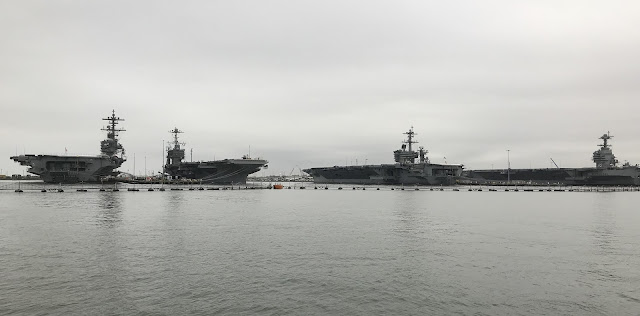 |
| Norfolk Naval Station's four carriers moored at the deep water navy piers at the far northern end of the base. From left to right: USS George H.W. Bush (CVN-77), commissioned on 10 January 2009; USS Harry S. Truman (CVN-75), commissioned on 25 July 1998; USS Abraham Lincoln (CVN-72), commissioned on 11 November 1989; and USS Gerald R. Ford (CVN-78). |
 |
| A closer look at the Nimitz-class carriers USS George H.W. Bush and USS Harry S. Truman. As the last of the Nimitz-class ships, the USS George H.W. Bush was designed as a 'transition ship' to the new Gerald R. Ford-class carriers and, as such, incorporated new technologies, such as improved propeller and bulbous bow designs, a reduced radar cross-section, and electronic and environmental upgrades. |
 |
| Looking at the lines of docked US Navy warships at Naval Station Norfolk from the bow of the Victory Rover tour boat as it returns to Norfolk's Town Point Park. |
 |
| Tugs push a barge loaded with containers, with the cranes of one of the Virginia Port Authority's cargo facilities in the background. |
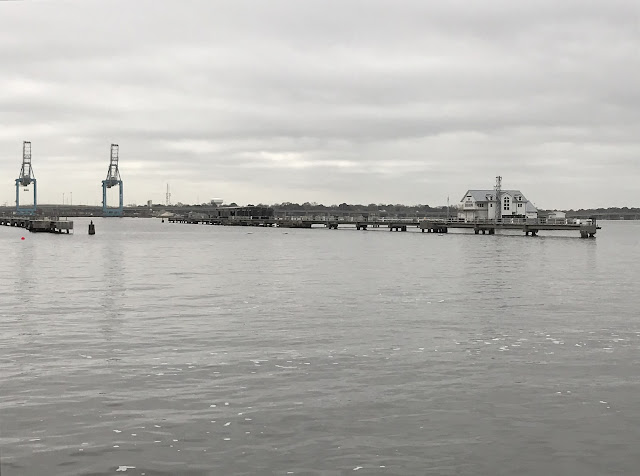 |
| The US Navy's Lambert's Point Deperming Station in the Elizabeth River. Built in the mid-1940s, the station provides deperming services to the US Navy Atlantic Fleet. Its two 1,140 foot long parallel piers can accommodate even the largest naval ships. Deperming treatment of a ship serves to reduce the magnetic signature of the hull to lower the risk of the ship detonating magnetic naval mines. The 'closed-wrap magnetic treatment' involves encircling the ship's hull and superstructure with heavy-gauge copper cables and then pulsing high electrical currents (up to 4,000 amperes) through the cables. This has the effect of "resetting" the ship's magnetic signature to the ambient level after flashing its hull with electricity. Deperming treatment is permanent and it is only administered to a ship once unless major repairs or structural modifications are made to the ship. |
 |
| A line of moored US Navy vessels in Portsmouth, Virginia, across the Elizabeth River from Norfolk. The vessel in the foreground is the USS Carter Hall (LSD-50), a Harpers Ferry-class dock landing ship commissioned on 30 September 1995. Behind it are moored three roll-on/roll-off cargo ships of the National Defense Reserve Fleet (NDRF), managed by the US Department of Transportation's Maritime Administration. The NDRF comprises mothballed vessels that can be re-activated within 20 to 120 days to provide shipping for the US Government during national emergencies. |
 |
| Another view of the roll-on/roll-off cargo ships MV Cape Race (T-AKR-9960), purchased by the US Navy in 1993; MV Cape Ray (T-AKR-9679), purchased in 1994; and MV Cape Rise (T-AKR-9678), purchased in 1993. Of note, the Cape Ray played a central role in the destruction of Syria's declared chemical weapons stocks in 2014. The ship, deployed to the Mediterranean with a US Army team of civilians and a Field Deployable Hydrolysis System, embarked 600 tons of the most dangerous chemical weapons. Destruction operations were then completed offshore over the course of 42 days between June and August 2014. |
 |
| Seen here cruising up the Elizabeth River is the tug Sarah Dann, operated by Dann Ocean Towing of Tampa, Florida. The tug was built in 1983 by Main Iron Works of Houma, Louisiana and is powered by two MTU 12V4000 M53 3,700 horsepower diesel engines. |
 |
| The Victory Rover returns to Town Point Park to disembark sightseers and prepare for the afternoon harbour cruise that departs at 2:00pm daily. |
.JPG)
.JPG)




.JPG)






.JPG)
.JPG)


.JPG)
.JPG)
.JPG)



.JPG)
.JPG)




















